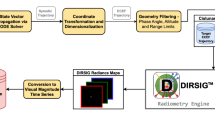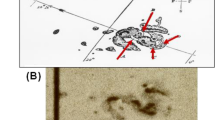Abstract
The Solar Terrestrial Relations Observatory (STEREO) is the third mission in NASA’s Solar Terrestrial Probes program. The mission is managed by the Goddard Space Flight Center (GSFC) and implemented by The Johns Hopkins University Applied Physics Laboratory (JHU/APL). This two-year mission provides a unique and revolutionary view of the Sun–Earth system. Consisting of two nearly identical observatories, one ahead of Earth in its orbit around the Sun and the other trailing behind the Earth, the spacecraft trace the flow of energy and matter from the Sun to Earth and reveal the three-dimensional structure of coronal mass ejections (CMEs) to help explain their genesis and propagation. From its unique side-viewing vantage point, STEREO also provides alerts for Earth-directed solar ejections. These alerts are broadcast at all times and received either by NASA’s Deep Space Network (DSN) or by various space-weather partners.
Similar content being viewed by others
References
M.B. Butler, STEREO critical design review, power subsystem presentation, 18–21 February 2003
G.J. Cancro, A.S. Driesman, Fault protection system development process for the STEREO spacecraft, in 55th International Astronautical Congress of the International Astronautical Federation, the International Academy of Astronautics, and the International Institute of Space Law, Vancouver, Canada, 4–8 October 2004, IAC-04-IAF-U.3b.08
Department of Defense, Aircraft internal time division command/response multiplex data bus. Institute of Environmental Sciences, Mount Prospect, Illinois, 21 September 1978, MIL-STD-1553B
Department of Defense, Product cleanliness levels and contamination control program. Institute of Environmental Sciences, Mount Prospect, Illinois, 11 April 1994, MIL-STD-1246C
Department of Defense, Requirements for the control of electromagnetic interference characteristics of subsystems and equipment. Institute of Environmental Sciences, Mount Prospect, Illinois, 20 August 1999, MIL-STD-461E
A. Driesman, B.W. Ballard, D.E. Rodriguez, S.J. Offenbacher, STEREO observatory trade studies and resulting architecture, in 2001 IEEE Aerospace Conference Proceedings, vol. 1, March 2001, pp. 1/63–1/80. doi:10.1109/AERO.2001.931696
JHU/APL, STEREO environmental definition, observatory, component, and instrument test requirements. JHU/APL, Laurel, Maryland, 2005, Document 7381-9003C
B. Kantsiper, J.C. Ray, J. Hunt, T. Strikwerda, Autonomous avoidance of structural resonances on the STEREO mission. American Institute of Aeronautics and Astronautics Guidance, Navigation, and Control Conference 2007, Hilton Head, South Carolina, 20–23 August 2007, AIAA-2007-6549
NASA Preferred Reliability Practices, Fault protection. NASA, Washington, DC, October 1995, Number PD-EC-1243
D.A. Ossing, JHU/APL STEREO mission operations concept. JHU/APL, Laurel, Maryland, 2001, Document 7381-9020
M.E. Pittelkau, Pointing definitions and pointing error metrics. JHU/APL, Laurel, Maryland, 21 November 2002, SRM-02-072
U.I. VonMehlem, STEREO RF telecommunications subsystem performance specification. JHU/APL, Laurel, Maryland, 21 February 2003, Document 7381-9350
Author information
Authors and Affiliations
Corresponding author
Rights and permissions
About this article
Cite this article
Driesman, A., Hynes, S. & Cancro, G. The STEREO Observatory. Space Sci Rev 136, 17–44 (2008). https://doi.org/10.1007/s11214-007-9286-z
Received:
Accepted:
Published:
Issue Date:
DOI: https://doi.org/10.1007/s11214-007-9286-z




